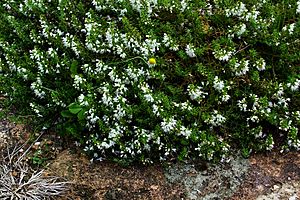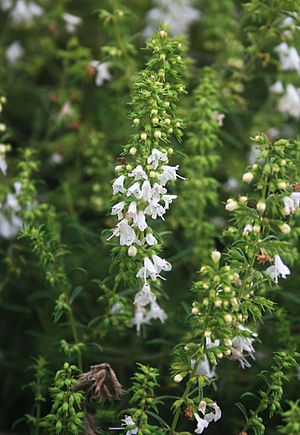Creeping savory facts for kids
Satureja spicigera, also known as creeping savory, is a type of flowering plant in the Lamiaceae family. This family is also known as the mint family, and it includes many well-known herbs like mint, basil, and oregano. Creeping savory is originally from parts of northeastern Turkey, the Caucasus region, and northwestern Iran.
This plant is a perennial shrub that grows low to the ground, spreading out like a mat. It's quite tough and can survive cold winters in USDA zones 6 through 9. Because of its low-growing habit, it's often suggested as a border plant for rock gardens or herb gardens.
Quick facts for kids Creeping savory |
|
|---|---|
 |
|
| Habit | |
 |
|
| The specific epithet spicigera means "bearing (flower) spikes". | |
| Scientific classification | |
| Genus: |
Satureja
|
| Species: |
spicigera
|
Contents
What is Creeping Savory?
Creeping savory is a small plant that belongs to the `Satureja` group. Its scientific name, Satureja spicigera, helps scientists around the world know exactly which plant they are talking about. The word spicigera in its name means "bearing spikes," which refers to how its flowers grow in spike-like shapes.
Where Does it Grow?
This plant naturally grows in specific areas of the world. You can find it in the wild in the northeastern parts of Turkey, across the Caucasus mountains (a region between the Black Sea and the Caspian Sea), and in the northwestern areas of Iran. These regions often have climates that suit its growth, with varying temperatures and soil types.
How Does it Look and Grow?
Creeping savory is a prostrate shrub, which means it grows very close to the ground and spreads horizontally rather than growing tall. It's a perennial, meaning it lives for more than two years, often coming back year after year. It's known for being quite hardy, able to withstand colder temperatures.
Growing Creeping Savory in Your Garden
If you live in an area with USDA zones 6 through 9, you can likely grow creeping savory in your garden. It's a great choice for the edges of garden beds, especially in rock gardens where its low-growing nature can fill in spaces between stones. It also fits well in herb gardens, where it can be easily reached for cooking.
Cooking with Creeping Savory
Creeping savory is a popular culinary herb. You can use it fresh, picking its leaves directly from the plant, or you can dry them to use later. Its flavor is quite strong, similar to winter savory (Satureja montana). Many people find its taste to be more intense than summer savory (Satureja hortensis), so a little bit goes a long way in your dishes! It can add a peppery, slightly minty flavor to meats, vegetables, and stews.

